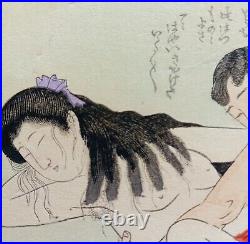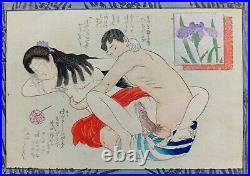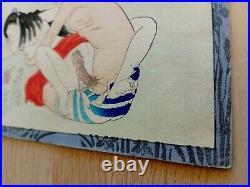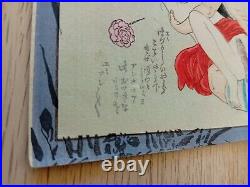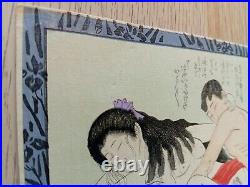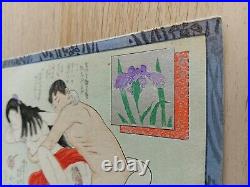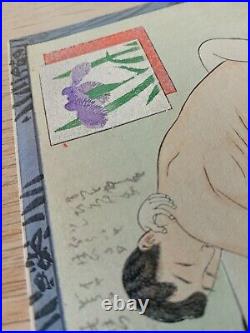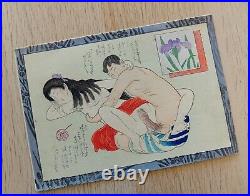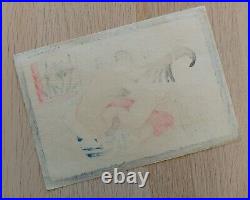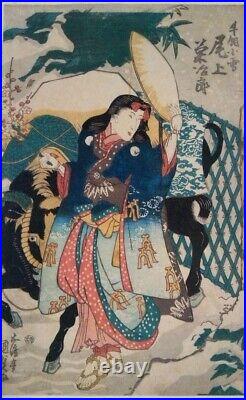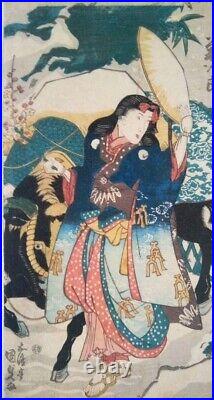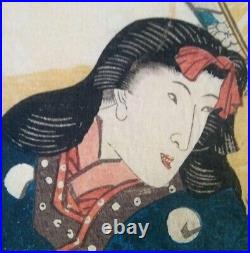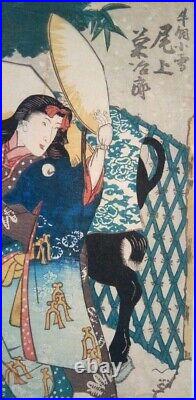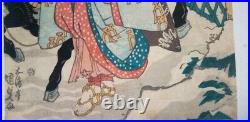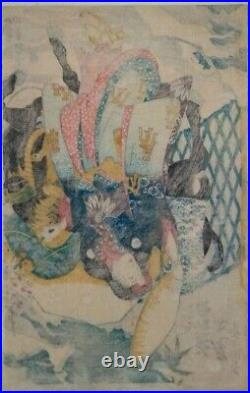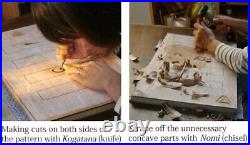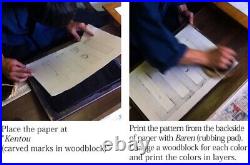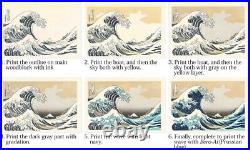Stunning romantic series of prints with very fine detail and vibrant colors. Quite a rare work of art. Age: Antique (circa 1900), Meiji period. Original woodblock print, woodcut. 19 x 13 cm. Shunga is a type of Japanese erotic art typically executed as a kind of ukiyo-e, often in woodblock print format. While rare, there are also extant erotic painted handscrolls which predate ukiyo-e. Translated literally, the Japanese word shunga means picture of spring; “spring” is a common euphemism for sex. The Japanese term Ukiyo-e translates as picture of the floating world. Bijin-ga is a portrait of a beautiful woman. Please note that antique and vintage artworks may have traces of time, so please review all photos.
Archive for September 11th, 2024
Original Japanese Shunga Art, Antique Erotic Woodblock print, Ukiyo-e, Bijinga
Author: adminSep 11
Ukiyoe Japanese woodblock print Utagawa Toyokuni III Ushikai Koyuki (Cowherd)
Author: adminSep 11
Size: 23.7 x 36.8 cm. Utagawa Kunisada, a prominent ukiyo-e artist from the late Edo period, was a disciple of Utagawa Toyokuni I. Among Toyokuni’s students, Kunisada excelled particularly in actor portraits and bijin-ga (pictures of beautiful women), becoming the most popular artist of the late Edo period. Kunisada became Toyokuni’s apprentice in his mid-teens, and it is said that Toyokuni was greatly impressed by Kunisada’s early talent. Absorbing Toyokuni’s techniques steadily, Kunisada debuted as an ukiyo-e artist in his twenties. Initially, he used the name Ichiyusai, but later adopted the name Gototei, derived from his family’s business, a ferry service at Kameido in present-day Koto Ward, Tokyo. This period marked the beginning of Kunisada’s rise to fame. Kunisada’s style is characterized by his keen observational skills, capturing the elegance and lively expressions of people. His bijin-ga often depicted women with elongated faces and thick, short necks, a common feature of the time. Kunisada’s numerous bijin-ga are noted for their ability to convey the breath and scent of the subjects, making them feel vividly real. This painting of a cowherd woman is truly a masterpiece of Kunisada’s beauty paintings and depicts her in a lively manner. If you have any questions, please feel free to ask us anything. We will respond with sincerity. Please comment before purchasing.
Yoshitoshi restored Ukiyoe woodblock print One Hundred Phases of the Moon y-4
Author: adminSep 11
This product will be produced by Takahashi Koubo(studio), introduced below. Yoshitoshi Tsukioka March 17, 1839 (April 30, 1839) – June 9, 1892 (Meiji 25) was an ukiyo-e artist active from the end of the Edo period to the middle of the Meiji era. Kyosai KAWANABE, Yoshiiku OCHIAI, and Yoshifuji UTAGAWA all studied under Kuniyoshi UTAGAWA and were in a relationship of brothers and apprentices, and Yoshiiku OCHIAI in particular was a worthy rival who even competed. In addition, many ukiyo-e artists, Japanese-style painters, and other painters are named after Yoshitoshi’s pupils or in his painting line, and are called ukiyo-e artists again. Monn by mount Inaba. Oda Nobunaga was attempting to capture Inabayama (Mount Inaba) Castle in Mino Province, but found himself unable to force a surrender and was struggling to attack effectively. To break the deadlock, Kinoshita Tokichiro (later to become Toyotomi Hideyoshi) is said to have led a small team of men up the mountain in order to launch a surprise attack from the far side of the castle. The man shown dragging the enormous gourd is Matajuro, the younger brother of Hachisuka Koroku, one of Hideyoshi’s subordinates (‘Ehon Taikoki’ [A Picture Book of the Biography of Toyotomi Hideyoshi], page 8, volume 1). The gourd was to be raised up as a sign upon successful infiltration of the castle grounds. Yoshitoshi: One Hundred Phases of the Moon, Tokyodo Shuppan, 1995. Commentary on “One Hundred Phases of the Moon”: Mr. Kenji Hinohara – Chief Curator of Ota Memorial Museum of Art. This print is brand new. With a history of more than 150 years, Takahashi Koubo(studio). Which has a workshop in Tokyo, will be a masterpiece that has been completely reproduced in the same way as at the time. What is Takahashi Koubo? Takahashi Studio is a woodblock printing studio established between 1855 and 1860. I would like you to watch the video, but it has a long history, and after the end of the war, it was invited by General MacArthur, showed the technology to Emperor Hirohito, and cooperated with the exhibition at the British Museum. The rank is [N], but there is no major damage. S:: Same quality as new. A: Excellent condition with no noticeable damage. B: Sense of use, but not bothersome. C: Normal, with scratches, stains, and other signs of use. D: Used item, may have scratches, stains, or other damage. E: Used item with use and damage. W: Items that are junk and badly damaged. V: Items belonging to vintage or antique and may be damaged in some way. The size will be around. Environmentally friendly and hygienic recycled materials may be used. Thank you for your understanding. We will pack it with hard paper and vinyl. It is not included in the product price. We keep our inventory well and properly. Stocked in our own warehouse, and we are waiting for your order. We can answer questions by holding the actual product in our hands. Where there are many of the most demanding (and nervous) buyers in the world. We have the ability to meet the expectations of the U. And other countries around the world. However, it is impossible to deliver next day. It will take a little time, but we will deliver from Japan with Japanese quality.
Comments Off
Filed under: yoshitoshi | Tagged as: hundred, moon, phases, print, restored, ukiyoe, woodblock, yoshitoshi
